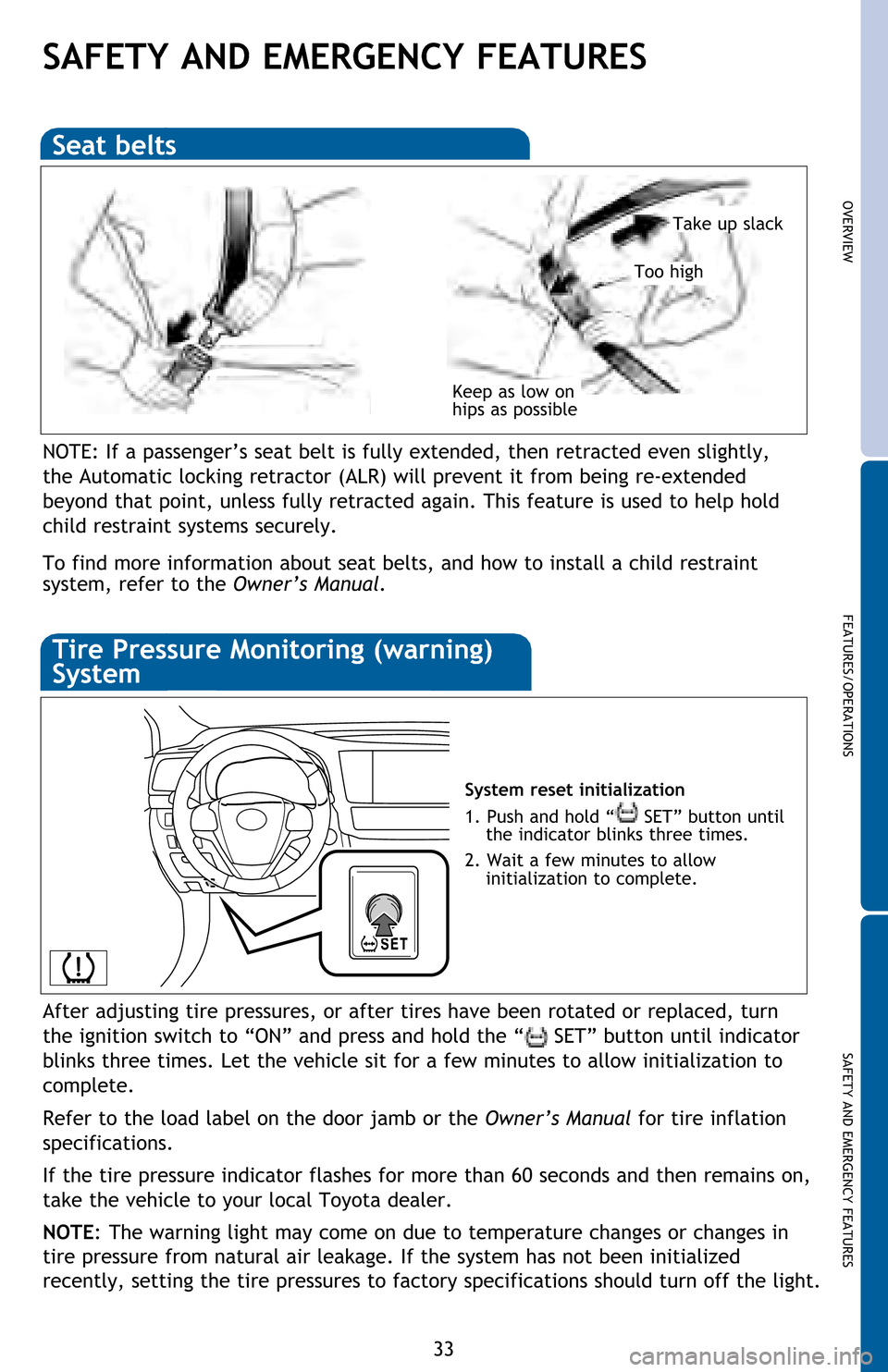Page 6 of 52
4
OVERVIEW
Indicator symbols Instrument cluster
2 If equipped1 If indicator does not turn off within a few seconds of starting engine, there may be a
malfunction. Have vehicle inspected by your Toyota dealer.
For details, refer to “Indicators and warning lights,” Section 2, 2016 Owner’s
Manual .Type 1
Type 2
Odometer
Shift position and shift range
Meter panel lights control button
Engine coolant temperature gauge
Service indicators and reminders
Tachometer
Multi-Information Display (MID)
Speedometer
Fuel gauge
Trip meter reset knob
Outside temperature
134236_QRG_Highlander_GUTS-R2.indd 412/17/15 2:54 PM
Page 15 of 52

OVERVIEW
FEATURES/OPERATIONS
SAFETY AND EMERGENCY FEATURES
13
Door-Power Liftgate (back door) (if equipped)
PushPush and hold
Instrument panel Open and close
Open: Push and hold
Close: Push and hold again
NOTE: If battery is disconnected, the power back door needs to be reinitialized.
Refer to the Owner’s Manual for more details.
Open onlyRemote
control
(without
Smartkey)Remote
control
(with
Smartkey)
Programmable Power Liftgate
1. When the liftgate reaches the desired height, push the rear liftgate close-
button (on the door jam of the liftgate) once. Press and hold the button until
the buzzer sounds.
2. To reset the height, with the liftgate open and not moving, press and hold the
rear liftgate close-button until it buzzes, and continue to hold until it buzzes
again -then let go. Push the same button to close the liftgate. When you next
open the liftgate it will open to the maximum height.
3. The height can also be set through the “Setup” screen on the audio display.
Setup > Vehicle Customization > Other Vehicle Settings > Power Back Door
Opening Adjust. Through this screen, there are 5 height options to choose
from.
NOTE: If the liftgate has stopped operating, check inside the glove box, on the
left side, to ensure the PWR DOOR OFF button has not been pushed.
For detailed instructions, see Owner’s Manual.
Page 27 of 52
25
OVERVIEW
FEATURES/OPERATIONS
SAFETY AND EMERGENCY FEATURES
Multi-Information Display (MID)
Type 1 (3.5” monochrome display)
Push “DISP” to change information in the following:
(1) Current fuel consumption
(2) Driving range
(3) Average fuel economy after refill
(4) Distance driven since last reset
(6) Eco driving indicator
Type 2 (4.2” color display)
Push “meter control switches” to change information in the following:
(1) Drive information
(2) Navigation system linked display
(3) Audio system linked display
(4) Dynamic Radar Cruise Control (DRCC)
(5) Lane Departure Alert (LDA) status
(6) Warning messages
(7) Settings display
Page 35 of 52

33
OVERVIEW
FEATURES/OPERATIONS
SAFETY AND EMERGENCY FEATURES
SAFETY AND EMERGENCY FEATURES
Keep as low on
hips as possible
Take up slack
Too high
Seat belts
System reset initialization
1. Push and hold “
SET” button until
the indicator blinks three times.
2. Wait a few minutes to allow
initialization to complete.
Tire Pressure Monitoring (warning)
System
After adjusting tire pressures, or after tires have been rotated or replaced, turn
the ignition switch to “ON” and press and hold the “
SET” button until indicator
blinks three times. Let the vehicle sit for a few minutes to allow initialization to
complete.
Refer to the load label on the door jamb or the Owner’s Manual for tire inflation
specifications.
If the tire pressure indicator flashes for more than 60 seconds and then remains on,
take the vehicle to your local Toyota dealer.
NOTE: The warning light may come on due to temperature changes or changes in
tire pressure from natural air leakage. If the system has not been initialized
recently, setting the tire pressures to factory specifications should turn off the light.
NOTE: If a passenger’s seat belt is fully extended, then retracted even slightly,
the Automatic locking retractor (ALR) will prevent it from being re-extended
beyond that point, unless fully retracted again. This feature is used to help hold
child restraint systems securely.
To find more information about seat belts, and how to install a child restraint
system, refer to the Owner’s Manual.